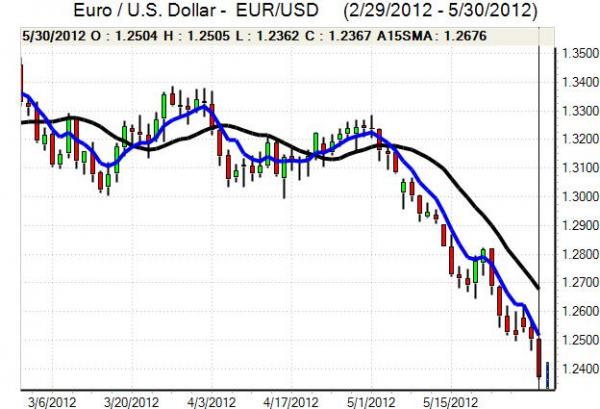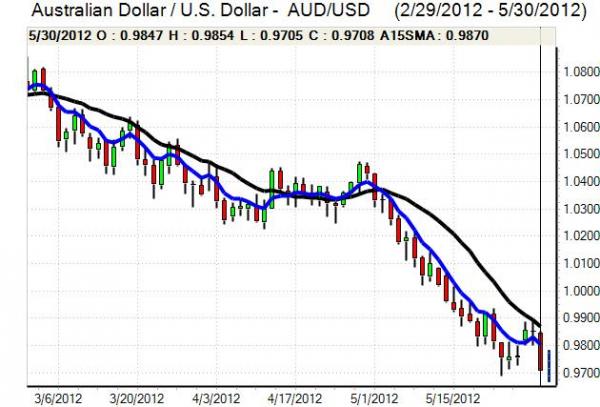EUR/USD
The Euro initially dipped to lows near 1.2425 against the dollar in Europe on Wednesday as underlying sentiment remained extremely fragile. There was a further sharp increase in peripheral yields during the session as fear surrounding the Euro-zone situation increased. There was a rise in Italian bond yields to above the 6.0% level at the latest 10-year bond auction and 5-year yields also rose sharply as investor demand was limited.
The main focus was on the Spanish economy, especially with increasing evidence of policy divisions. The resignation of Bank of Spain Governor Ordonez had a negative impact on sentiment, especially as he stated that he had been muzzled while in office. There was further confusion surrounding the Bankia rescue package as the ECB stated that it had not been consulted on the plans to issue government bonds to be used as collateral. There were, however, still expectations that the central bank would reject the proposals.
Spanish bond yields increased sharply to a peak around 6.80% and there were further fears that the situation was rapidly becoming unsustainable with Spain effectively frozen out of capital markets. The latest ECB data recorded a sharp slowdown in money-supply growth and lending which maintained fears over underlying recession conditions. There were mixed Greek opinion polls.
The Euro spiked higher after the European Commission proposed that there should be a move towards banking union, but the currency quickly ran into selling pressure.
The US pending home sales data was weaker than expected with a 5.5% decline in pending home sales, but there was little impact given the Euro-zone focus. Similarly, there were several Fed comments during the day, but no evidence of a move towards additional quantitative easing at this time with the next FOMC meeting due in three weeks.
The Euro retreated to test the 1.24 level during the US session and a break below this level pushed the currency to fresh 22-month lows near 1.2365 before a tentative correction higher.

Source: VantagePoint Intermarket Analysis Software
Call now and you will be provided with FREE recent forecasts
that are up to 86% accurate* 800-732-5407
If you would rather have the recent forecasts sent to you, please go here
Yen
The dollar was unable to regain the 79.50 level against the yen on Wednesday and dipped sharply during the European session. Risk appetite tended to dominate markets and there were further defensive inflows into the Japanese currency as fear intensified.
The US currency was undermined on yield grounds as benchmark US Treasury yields declined to record lows. The Euro retreated to lows below 97.50 against the Japanese currency, moving close to lows seen in January. There was evidence of retail yen buying in the context of margin calls on short positions against currencies such as the Australian dollar.
The Japanese industrial production data was weaker than expected with a 0.2% May gain, but the housing data was stronger than expected and the dollar consolidated in the 78.75 region.
Sterling
Sterling initially came under fresh selling pressure after breaking the 1.56 support level against the dollar with lows near 1.5550 and sentiment remained negative after a rally failed to regain the former support level.
Bank of England MPC member Fisher stated that a break-up of the Euro could not be excluded which reinforced market fears surrounding the Euro and contributed to further defensive support for UK bonds. Benchmark gilt yields declined to fresh record lows during the session. There was a small increase in consumer confidence according to the latest GfK survey and immediate hopes surrounding consumer spending may stay higher.
Overall risk conditions will be watched very closely and further stresses within the European banking sector would tend to have a negative Sterling impact and potentially offsetting scope for defensive inflows and the net result is liable to higher volatility.
Swiss franc
The Euro retreated back to below 1.2010 against the franc on Wednesday and the US currency was again able to take advantage of the Euro’s vulnerability as it pushed to fresh 2012 highs above 0.97 against the Swiss currency.
There were continuing expectations of defensive inflows into the franc as the Euro-zone stresses continued to intensify and the 1.20 minimum Euro level is liable to be tested even further.
The KOF business confidence index rose to 0.81 for May from a revised 0.43 previously which will increase speculation that the economy is gaining some degree of support from a weaker franc against the US currency.

Source: VantagePoint Intermarket Analysis Software
Call now and you will be provided with FREE recent forecasts
that are up to 86% accurate* 800-732-5407
If you would rather have the recent forecasts sent to you, please go here
Australian dollar
The Australian dollar initially dipped towards the 0.9750 level on Wednesday and after failing to regain the 0.98 region, there was renewed selling pressure during the New York session with a test of support near 0.97.
Risk appetite was generally weaker which undermined the Australian currency, especially with equity markets on the defensive and pressure intensified as commodity prices were subjected to further weakness.
The domestic building approvals data was much weaker than expected with a 8.7% monthly decline which triggered 7-month Australian dollar lows below 0.97 before a limited correction.



